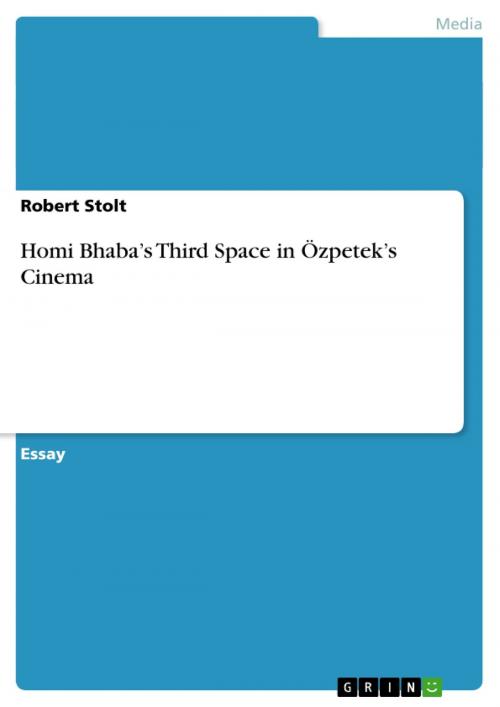| Author: | Robert Stolt | ISBN: | 9783640632015 |
| Publisher: | GRIN Publishing | Publication: | May 27, 2010 |
| Imprint: | GRIN Publishing | Language: | English |
| Author: | Robert Stolt |
| ISBN: | 9783640632015 |
| Publisher: | GRIN Publishing |
| Publication: | May 27, 2010 |
| Imprint: | GRIN Publishing |
| Language: | English |
Essay from the year 2010 in the subject Film Science, grade: 1,3, University of St Andrews, language: English, abstract: In his attempt to break down binary thought structures that characterise interactions between different cultures, in his 1994 work Location of culture, Homi Bhabha defines the term of third space as a place where identities can be renegotiated. The third space can be located beyond the bipolarity of 'us' and 'them' and thus is a territory where we can escape the dilemma of dichotomies and hierarchies. Özpetek, in Hamam, il bagno turco [Ferzan Özpetek, 1992] as well as in Harem suaré [Ferzan Özpetek, 2001], seizes on the idea of Bhaba's third space to describe the encounter with the cultural other and the erotic attraction to the other. In Hamam as well as in Harem Özpetek is accused of applying an Orientalist approach by showing an utopian imagination of the Oriental Other. According to Said, the notion of the Orient is a discursive construct of the West, while the underlying construction is strictly dichotomic - 'us' vs. 'them' (Said 1978:44). Indeed, imaginary projections of the Orient are often claimed to be mere imaginations and explanations of the Other and the foreign (Breger & Döring 1998: 30). However, in Özpetek's films the constructs of Turkey should not be seen as merely following the Orientalist canon, but should rather be 'understood as a measure of Özpetek's nostalgia, as a transcultural person who now lives in Italy' (Anderlini 2004: 165). In his cinematic processing of concrete life experiences of diaspora, Özpetek relies on the concept of the third space, by applying it as a guide for a global re-mapping and leaving behind the binary division of West vs. East and traditional vs. modern. What is discussed in this essay is the hamam as the third space in Özpetek's Hamam and Harem, where people can negotiate their fixed cultural identities and hybridise with the Other. Thus, the third space is applied as an intercultural medium, a space for reflection and mediation (Breger & Döring 1998: 27). Before focusing on the hamam as the third space, the interaction between East and West, which makes up a crucial part of both films, shall be looked at in chapter two. Furthermore, the hamam will be analysed in chapter three as not only a divested, but also queer space. On top of that, in part four, the emphasis will be placed on the female empowerment that is triggered through the characters' experience in the hamam. Lastly, a retrospective analysis of the paper will conclude the essay.
Essay from the year 2010 in the subject Film Science, grade: 1,3, University of St Andrews, language: English, abstract: In his attempt to break down binary thought structures that characterise interactions between different cultures, in his 1994 work Location of culture, Homi Bhabha defines the term of third space as a place where identities can be renegotiated. The third space can be located beyond the bipolarity of 'us' and 'them' and thus is a territory where we can escape the dilemma of dichotomies and hierarchies. Özpetek, in Hamam, il bagno turco [Ferzan Özpetek, 1992] as well as in Harem suaré [Ferzan Özpetek, 2001], seizes on the idea of Bhaba's third space to describe the encounter with the cultural other and the erotic attraction to the other. In Hamam as well as in Harem Özpetek is accused of applying an Orientalist approach by showing an utopian imagination of the Oriental Other. According to Said, the notion of the Orient is a discursive construct of the West, while the underlying construction is strictly dichotomic - 'us' vs. 'them' (Said 1978:44). Indeed, imaginary projections of the Orient are often claimed to be mere imaginations and explanations of the Other and the foreign (Breger & Döring 1998: 30). However, in Özpetek's films the constructs of Turkey should not be seen as merely following the Orientalist canon, but should rather be 'understood as a measure of Özpetek's nostalgia, as a transcultural person who now lives in Italy' (Anderlini 2004: 165). In his cinematic processing of concrete life experiences of diaspora, Özpetek relies on the concept of the third space, by applying it as a guide for a global re-mapping and leaving behind the binary division of West vs. East and traditional vs. modern. What is discussed in this essay is the hamam as the third space in Özpetek's Hamam and Harem, where people can negotiate their fixed cultural identities and hybridise with the Other. Thus, the third space is applied as an intercultural medium, a space for reflection and mediation (Breger & Döring 1998: 27). Before focusing on the hamam as the third space, the interaction between East and West, which makes up a crucial part of both films, shall be looked at in chapter two. Furthermore, the hamam will be analysed in chapter three as not only a divested, but also queer space. On top of that, in part four, the emphasis will be placed on the female empowerment that is triggered through the characters' experience in the hamam. Lastly, a retrospective analysis of the paper will conclude the essay.















